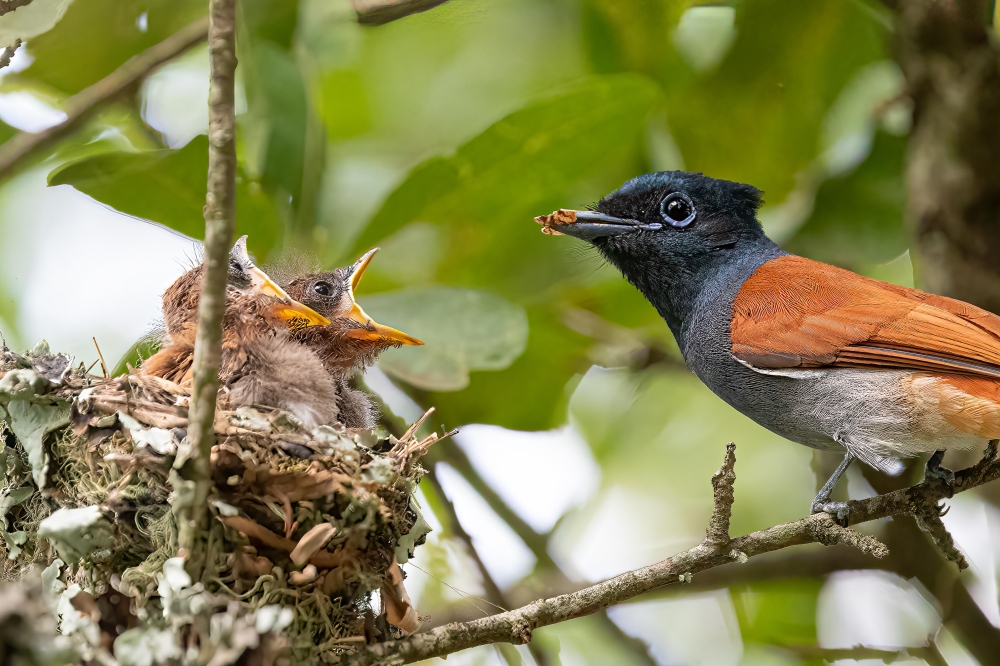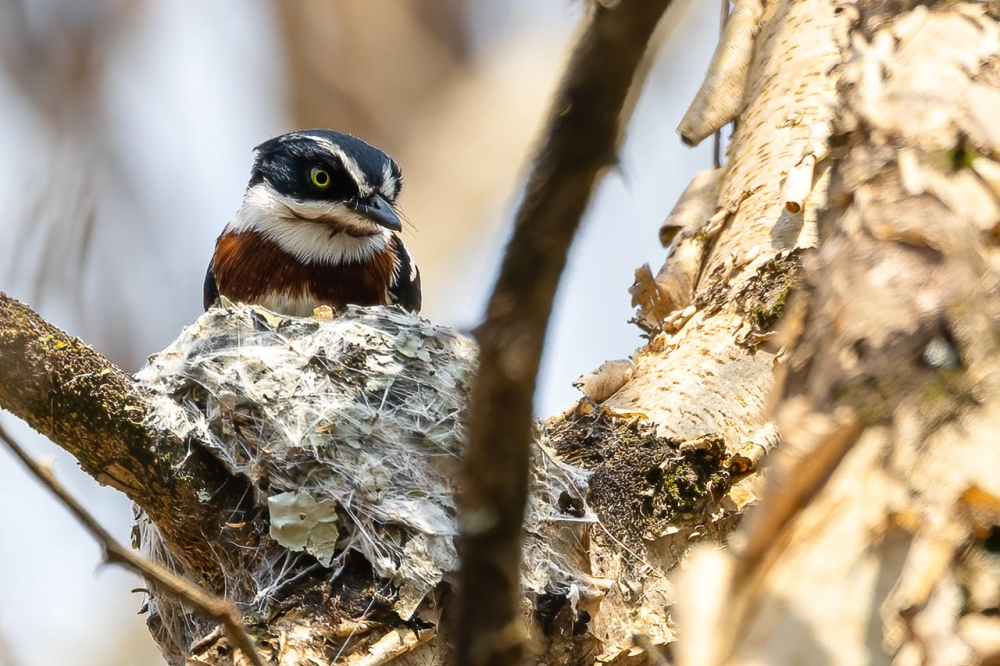

I am amazed by the variation of nests that can be found – from the most intricate nests, weaved from strands of reed and grass, and those tunnelled into the banks of a river or the cavity of a tree, all the way through to those so large they weigh in excess of 100kg!
In Rwanda we have approximately 13 different species of Weavers and all construct enclosed ball shaped nests, but that is where the similarities stop. The nest design differs with each species: the environment in which the nest is constructed, the shape of the nest, the location and length of the entrance, even the width of the material used to weave the nest changes. Both Village Weavers and Black-headed Weavers build their nests in colonies – large groups of nests in one location.


Black-headed Weavers prefer to construct their nests next to, or hanging over water for protection against predators, whereas Village Weavers are quite happy to build their colonies next to, or near human structures. The male of both species will weave multiple nests during a breeding season in order to attract mates and each individual weaver has his own unique weave. Each nest takes about 12-15 hours to construct.
When a female arrives, the males will hang and display under their nests by noisily fluttering their wings. Each male can have up to five mates at once, and a single male Village Weaver can have up to 20 mates in one breeding season. In stark contrast, Spectacled Weavers form a pair bond that can last for years. The male will sing to his mate throughout the year to reinforce their pair bond and the pair will return to the same nesting site each year. The male - watched by the female - takes between 1-3 weeks to build up to four nests, the female will then add the interior lining to her chosen nest. After their hatchlings have fledged and left the nest White-collared Olivebacks are known to reuse the nests to raise their own young.
The open cup nest is used by lots of different species here in Rwanda, including canaries, flycatchers, robins and batis’. The small nests with high sides are tightly woven together using grass, vines and creepers. The inside of the nest is then lined with softer material. To conceal the nest, the outside will be camouflaged using bark, lichen or moss, live and dead leaves from the local area which are held together using spiderweb. The Chinspot Batis is known for this type of very well camouflaged nest and whilst it prefers the Acacia trees to build its nests, other species use hedgerows or thick bushes and other trees.
The Hamerkop takes nest building to the extreme, they build the largest tree nest of any single pair of birds. Each enclosed structure takes between 10-12 weeks to construct and includes around 8,000 separate items of sticks and leaf litter. Material is even added after the eggs have been laid, which can also include feathers, reeds, bones and even plastic toys. The Hamerkop breeding season can occur at any time during the year, depending on availability of food and weather conditions. The nest is built jointly by the pair and the actual process of building the nest maintains their pair bond. Found in the fork of large trees the pair will construct the nest for a couple of hours in the early morning and late afternoons. A diversity of other animals take advantage of unoccupied nests, some species of owls and kestrels are even known to evict Hamerkops from their nests.
The Pied Kingfisher, Malachite Kingfisher and various Bee-eaters construct their nests by excavating a hole and tunnelling into sand or mud banks. These tunnels are often dug on a gradient to stop water entering. At the end of the tunnel a chamber is dug which is where the eggs are subsequently laid. Swallows also use mud to construct their nests but in a totally different way – they mix mud pellets with the saliva in their mouth which is then taken to the nest site and pasted in place.
The pellets are placed in rows, much like us humans would build a brick wall. The pellets bind together and are set hard from the heat of the sun. The process takes the pair up to seven weeks to construct a really effective shelter.
Instead of tunnelling into sand and banks, woodpeckers and barbets excavate holes in tree trunks with their bills to create nest cavities which are lined with wood shavings. These nest holes can also be found on the underside of lateral branches to reduce rain water entering the nest. Barbet nests are usually guarded by one of the parents, the pair will rotate sentry duty.
There is a group of birds known as brood parasites that don’t build their own nests but rather lay their eggs in the nests of other birds’, the host parents will raise their young for them. The cuckoo family is well known for this behaviour, other brood parasites found in Rwanda include the various honeyguides, indigobirds, widowbirds and whydahs. Brood parasites use egg mimicry, chick mimicry, as well as eliminating the competition in order to fool the host. Brood parasites adapt the size, shape and colour of their eggs to look like the eggs of their host. The female parasite will also remove an egg from the host’s nest so that when her egg is added the same number remains. Indigobirds and Whydah chicks have the same marking and colouration as their host chicks to ensure they get fed by the host parents. The parasite chicks will develop at a faster rate than their host nest mates so they can either outcompete or even get rid of their nest mates.
Throughout the year, nests can be seen across Rwanda - in our gardens and cafes, on the trees that line the roads as well as the nature reserves and national parks. The new parents will be gathering lots of food for their young and it’s worth remembering that swallows help control mosquitoes, owls help control rats and mice and eagles help control snakes. If you find a nest – please give them space and not remove them, even if they make a little mess it won’t be for long. Also, look in hedgerows and trees before trimming them back. Birds of all types and sizes are awesome, their presence or absence is a great indicator of the health of the environment we live in and the world we live in.


